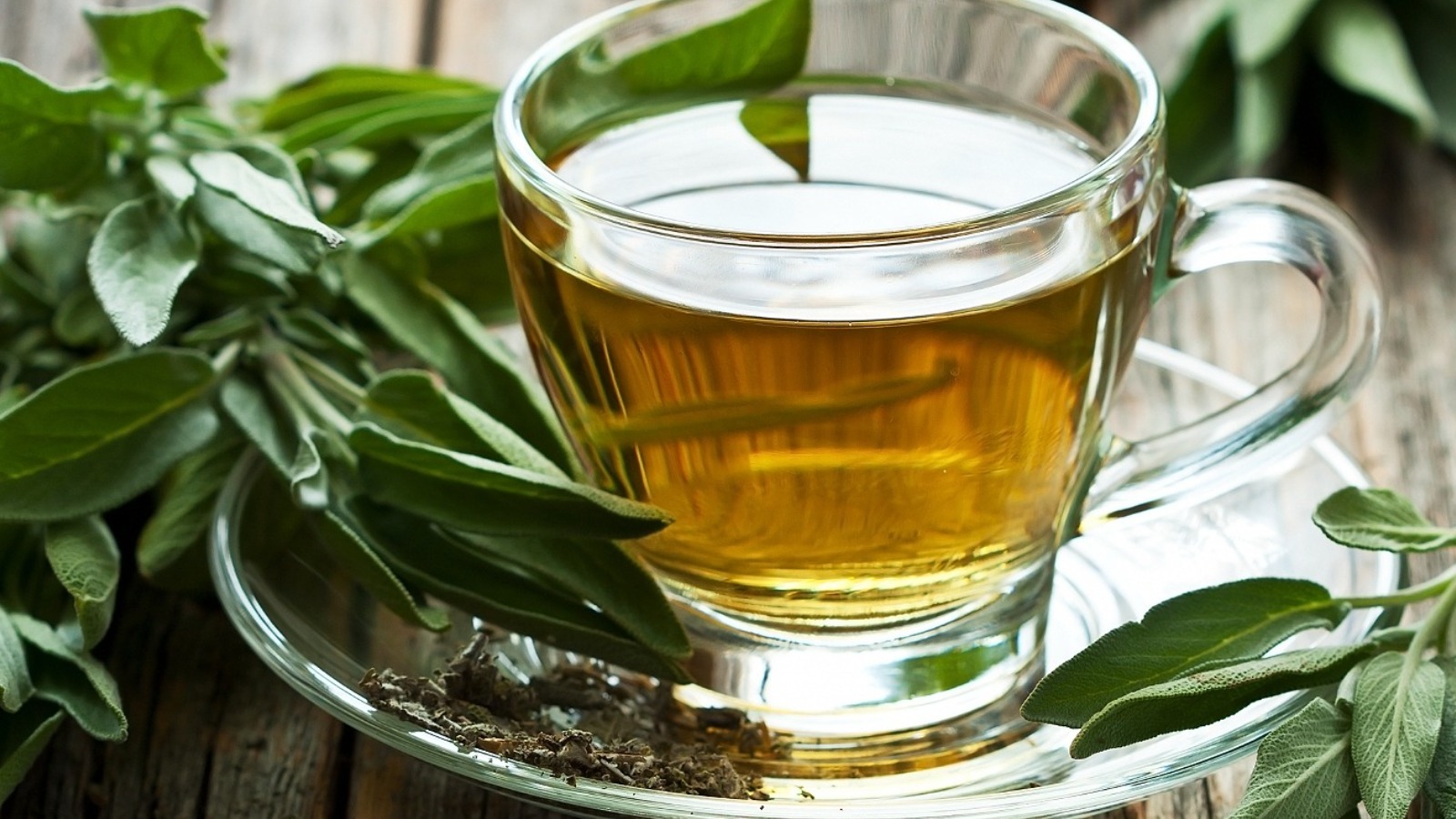Fresh Vs. Dried Sage: What’s The Difference? – Mashed

Fresh Vs. Dried Sage: What’s The Difference? – Mashed
Just because the time to prepare holiday stuffing has come and gone doesn’t mean you have to leave those flavors in the past. Sage (Salvia officinalis), an herb that often makes an appearance around the festive fall and winter months, can play a role in your recipes any time of year.
This perennial herb grows natively in the Mediterranean and has fuzzy light green leaves, per Masterclass. In the Middle Ages, sage was used widely for its medicinal purposes to treat anything from sore throats to typhoid fever. According to Healthline, sage is high in nutrients. It contains vitamin K, many types of antioxidants, and is also antimicrobial, which can help support the well-being of your mouth and teeth.
Sage has a bold, earthy, herbal flavor that will overpower other ingredients if you’re not careful. In the grocery store, you’ll have the option of fresh sage or the dried kind that comes in a spice jar. The biggest sage mistake you’re making when cooking with this herb is likely not adjusting properly when substituting dried sage for the fresh variety, because there are key differences between the two.
Dried sage is more potent than fresh
 5ph/Getty Images
5ph/Getty Images
If you’re opting to purchase dried sage, there are a few things to consider first, like whether you need ground sage or dry-rubbed sage. According to McCormick Science Institute, ground sage comes from processing the leaf into a fine powder. Rubbed sage is made when the entire leaf gets dried out and then rubbed together, creating a flakey mix. This variety is less potent than ground sage. You can use about a teaspoon of dried sage for every two teaspoons of rubbed sage.
The Rocky Mountain Spice Company reports that ground sage is best used for adding a “woody” flavor to your cooking. But if you want that distinct sage taste, you’ll need to use dry-rubbed. People typically use dry-rubbed sage for items like Thanksgiving stuffing and sausage.
Fresh sage is a whole different animal. You should look for leaves in the grocery store or in your garden that aren’t dry, brown, or spotted, per How To Culinary Herb Garden. Fresh sage is a bit milder than dried sage, Spiceography explained. For best results, add fresh sage into your recipe at the end. However, if you’re using dried sage, you should incorporate the spice at the beginning of cooking to allow time to tame the strong flavors. With this sage advice, you’ll always know the right type of sage to use.
Related News & Content
-

Gutenberg: Restrict Top Level Blocks, But Not Child Blocks
Gutenberg: Restrict Top Level Blocks, But Not Child Blocks,Background I've created a custom top level "page section" block, to work with my existing theme. I've like to restrict top level blocks to ONLY that one block. However, I don't want to di... Tags: block editor stackexchange.com WordPress Development Stack Exchange -

How do I load styles into the block editor admin screen?
How do I load styles into the block editor admin screen?,The core file 'load-styles.php' generates css styles. Some of the styles interfere with the block editor. I would like to pass in my own style rules that override the styles generated by 'load-styl... Tags: block editor stackexchange.com WordPress Development Stack Exchange -

Installing WordPress in a subdirectory
Installing WordPress in a subdirectory,I am trying to install wordpress into a subdirectory of a website. I simply want to build the client's new site in this subdirectory, so a separate and new WP install in this subdirectory, and the... Tags: installation stackexchange.com WordPress Development Stack Exchange -

Custom theme and plugin updating
Custom theme and plugin updating,History: I'm working on a project for a client that involves building 27 unique websites that are built on wordpress. I say unique, because (for reasons that are not worth going into here) they ar... Tags: automatic updates plugin development stackexchange.com theme development WordPress Development Stack Exchange -

Rewrite nested urls for custom post type
Rewrite nested urls for custom post type,I have a problem with nested permalink. I have a structure of urls like that: Catalog -> Category -> Product My urls are: www.domain.com/catalogs (for archive catalog) www.domain.com/catal... Tags: custom post types stackexchange.com url rewriting WordPress Development Stack Exchange -

Ajax not working to insert, query and result data
Ajax not working to insert, query and result data,On my site, through a form I send/register same information in database, do a SELECT/query and return it! Return the last table saved in database, just that user just entered on the form (along wit... Tags: Ajax database functions plugin development stackexchange.com WordPress Development Stack Exchange -

Israel at war, day 204: Hamas airs video of Israeli hostages, one with U.S. citizenship
Israel at war, day 204: Hamas airs video of Israeli hostages, one with U.S. citizenship,Hamas Studying Israel's Response to Position on Cease-fire Talks Gaza Aid Shipments Resume From Cyprus IDF: Two Palestinians Killed After Firing on IDF Outpost in the West Bank Pro-Palestinian Protest Leader Banned From Columbia Campus Here's What You Need to Know 204 Days Into the War Tags: 2023 Israel Gaza War haaretz.com Israel News -

Israeli strike destroyed IVF embryos in Gaza’s largest fertility clinic
Israeli strike destroyed IVF embryos in Gaza's largest fertility clinic,The Strike Destroyed Over 4,000 Embryos and 1,000 More Specimens of Sperm and Unfertilized Eggs. 'My Heart Is Divided Into a Million Pieces,' Said Bahaeldeen Ghalayini, Founder of Gaza's Largest Fertility Clinic Tags: 2023 Israel Gaza War haaretz.com IDF Israel News Israel war crimes Palestinians -

Netanyahu’s Office chief offers witness in PM trial paid vacation ahead of her testimony
Netanyahu's Office chief offers witness in PM trial paid vacation ahead of her testimony,A Legal Advisor at the Prime Minister's Office – Whom Netanyahu Once Tried to Oust – Is Due to Testify in the Case Involving the Misuse of State Funds for Catering Services at Netanyahu's Residences in a Few Weeks Tags: Benjamin Netanyahu haaretz.com Israel News Israeli politics -

Carol Kirkwood stuns in figure-hugging dress amid BBC Breakfast technical chaos
Carol Kirkwood stuns in figure-hugging dress amid BBC Breakfast technical chaos,CAROL Kirkwood stunned in a figure-hugging dress amid a technical blunder. BBC Breakfast was flung into chaos this morning after a string of sound issues. However Carol, 61, was all smiles as she p… Tags: BBC BBC Breakfast BBC ONE Carol Kirkwood mirror.co.uk The Scottish Sun TV News TV UK daytime TV -

Families ‘to sue prison’ where loud inmates ‘terrorise kids’ with screaming
Families 'to sue prison' where loud inmates 'terrorise kids' with screaming,Residents living next door to a new prison who say their kids have to sleep wearing headphones and some leave during weekends due to the racket are threatening to sue the prison service Tags: mirror.co.uk Neighbours from hell prisons Scottish government The Mirror -

Doctor Strange’s Secret Wars Role May Be More Important Than You Thought – Looper
Doctor Strange's Secret Wars Role May Be More Important Than You Thought - Looper,According to entertainment leaker Alex Perez, Doctor Strange will find himself confronting his inner struggles as he headlines "Avengers: Secret Wars." Tags: Fiction Looper looper.com Marvel Cinematic Universe Science Star Wars The Universal Monsters franchise -

Choctaw artist Jeffrey Gibson confronts history at US pavilion as its first solo Indigenous artist
Choctaw artist Jeffrey Gibson confronts history at US pavilion as its first solo Indigenous artist,Jeffrey Gibson’s takeover of the U.S. pavilion for this year’s Venice Biennale contemporary art show is a celebration of color, pattern and craft Tags: 109377793 abcnews.go.com Article Entertainment General news Indigenous people Keycat Keytags Race and ethnicity U.S. News visual arts World news -

Mexican film wins top prize at Moscow International Film Festival while major studios boycott Russia
Mexican film wins top prize at Moscow International Film Festival while major studios boycott Russia,A Mexican film has won the top prize at the Moscow International Film Festival which took place as major Western studios boycott the Russian market and as Russia’s war in Ukraine grinds into its third year Tags: 109702159 abcnews.go.com Article Entertainment Fairs and festivals General news Keycat Keytags Movies Russia Ukraine war World news -

Sandra Oh reenacts funny ‘Princess Diaries’ scene for Anne Hathaway
Sandra Oh reenacts funny ‘Princess Diaries’ scene for Anne Hathaway,Sandra Oh re-created a beloved scene from "The Princess Diaries" to announce Anne Hathaway's recent appearance on "The Kelly Clarkson Show." Tags: Movies popculture today TODAY.com -

Bestselling author Emily Henry shares her latest book recommendations
Bestselling author Emily Henry shares her latest book recommendations,What is Emily Henry reading right now? She shares book recommendations. Tags: books popculture today TODAY.com -
L-Acoustics 'immerses' audiences at Italian hip-hop show – Installation
L-Acoustics 'immerses' audiences at Italian hip-hop show - Installation,L-Acoustics L Series, paired with L-ISA spatial audio technology to create immersive experiences at a concert in Florence, Italy, by Coez & Frah Quintale -

Ahsoka Season 2: What We Know So Far
Ahsoka Season 2: What We Know So Far,Ahsoka Season 2 is on the way, so let’s go over what we know about the next installment of the Star Wars show. Tags: Ahsoka cinemablend.com Disney+ longform Rosario Dawson Sci fi What We Know So Far
Warning: file_get_contents(https://www.scienceradars.com/wp-output-content.php?pg=1&cat=&kw=&lvl=): Failed to open stream: HTTP request failed! HTTP/1.1 526 in /home/wwwroot/xuenou.com/wp-content/themes/chromenews/template-parts/content.php on line 169
Warning: file_get_contents(https://www.bayuexiang.com/wp-output-content.php?pg=1&cat=&kw=&lvl=): Failed to open stream: HTTP request failed! HTTP/1.1 526 in /home/wwwroot/xuenou.com/wp-content/themes/chromenews/template-parts/content.php on line 173
TrendRadars
The Most Interesting Articles, Mysteries and Discoveries

“Without prior warning, he immediately left the band”: Sepultura drummer Eloy Casagrande abruptly quits, replacement revealed
How to change scroll direction?

“Django stretched the guitar imagination to its limit. He was the fastest, the most creative”: What Django Reinhardt can teach today’s blues players




























































